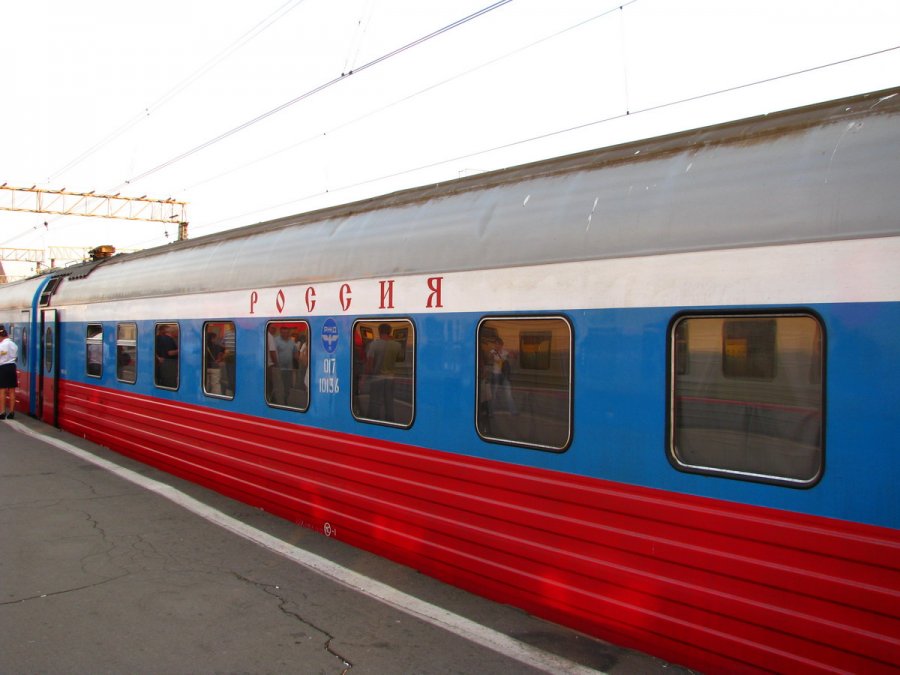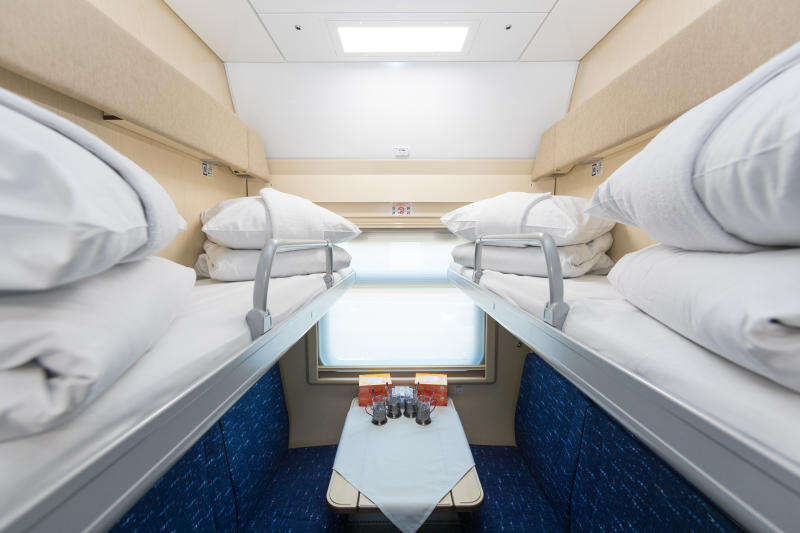Rossiya
Runs
every day
Travel time
7 days
Distance
9259 km
146 stops
on the way
A journey on the Trans-Siberian Express train Rossiya is the longest train ride in the world. The train made its first trip in 1966. It departs from Yaroslavsky train station in Moscow and after crossing two continents and six time zones, arrives in Vladivostok 7 days later. The train stops in approximately 140 cities. At the 1778th km of the Trans-Siberian Railway, the train crosses the border between Europe and Asia, and beginning at the 5276th km the Rossiya runs 207 km along Lake Baikal.
The colors of Russian flag are used in both the train’s exterior and interior. The Rossiya is considered one of the best trains in Russia in terms of service, friendliness of staff and upkeep. In September 2016, two of the Rossiya trains received a thematic carriage exterior design as part of a program to protect Amur tigers and Far Eastern leopards: images of these rare animals were printed on the wagons.
The train has second and third-class carriages. Second class compartments have 4 berths – two upper and two lower ones. Second class tickets are available with and without meals. Each cabin has a TV and 220V socket. Doors are equipped with an access control system. Bedlinen is included to the price of all 2nd class tickets. Third class is an open carriage without any closed compartments. It has 54 sleeping berths arranged in two levels. The train has a nice dining car with a special menu for passengers. There is a shower in a special carriage that can be used by all passengers (extra charge).
Schedule
Testimonials
“
Booked several trips with RussianRail
I have used RussianRail for six legs of a trip from Vladivostock to Astana and each time the web booking system has been efficient and simple to navigate. Additionally I had occasion to communicate with the office to investigate possibilities and the responses have been immediate and courteous. I only wish that I was able to book my train travel from Kazakhstan onwards with them as the KZ site is hopeless compared to Russianrail. I certainly have no problem in recommending RR.
“
Great service - highly recommended
We used Russian Rail to book the second leg of our Trans Siberian journey, going from Irkutsk to Vladivostok on the 002 Rossiya. The booking process was seamless. What really impressed us was that they refunded us a considerable amount when the exchange rate had changed in our favour on the day of booking. Thank you, Russian Rail, for your honesty and integrity. We would not hesitate to recommend you to other rail users.
“
Booked several trips with RussianRail
I have used RussianRail for six legs of a trip from Vladivostock to Astana and each time the web booking system has been efficient and simple to navigate. Additionally I had occasion to communicate with the office to investigate possibilities and the responses have been immediate and courteous. I only wish that I was able to book my train travel from Kazakhstan onwards with them as the KZ site is hopeless compared to Russianrail. I certainly have no problem in recommending RR.
“
Booking through your company made our life easier
Booking through your company made our life easier when organising such a complex trip from our perspective. Communication was excellent and to break the trip into four parts from Beijing/Ulaan Baatar/Urkutsk/Moscow/St Petersburg this was essential. We would recommend tour company.
“
Perfectly on track
Russian Rail made booking my entire Trans-Siberian adventure incredibly simple. Navigating a foreign system can seem intimidatingly opaque, not least with an unfamiliar alphabet and remote stations, but Russian Rail made it transparent. The site provided complete clarity and therefore complete freedom to choose the times, cabins, and stops that I wanted, even at the last minute. The booking process was easy and swift. Fantastic!
“
One of the best trips I've been on
It was one of the best trips I've been on. The train ride, the people and the views. It is a must do. Thank you for helping me with my booking and making the reservation process simple.
History of the Rossiya train
The Rossiya train traverses the 9,288 km of the Trans-Siberian Railway in just over 6 days, and is arguably the most famous train in Russia. Of course, we can’t talk about the Rossiya train without first looking at the history of the world’s longest passenger train route.
The Trans-Siberian in Imperial Russia
Construction on the Trans-Siberian Railway began in 1891, and aimed to link St Petersburg and Moscow with the most important Siberian and Far Eastern cities, populate the Russian Empire’s far eastern lands, and harness the wealth of natural resources there.
Did you know? The construction of the Trans-Siberian was actually initiated by the future Tsar Nicholas II, who moved the first pieces of earth and rock himself.
Building the Trans-Siberian was a true feet of human endeavour – tens of thousands of workers toiled on the railway, hacking their way through permafrost, mountain ranges and endless forests, bridging wide swamps and raging rivers, and braving the bleak eastern winter. The efforts were worth it: upon completion it became possible for the first time in history to travel from the Atlantic Ocean to the Pacific Ocean solely by rail.
Did you know? It came at a cost of 1 billion 455 million roubles – around $25 billion dollars in today’s money.
The Trans-Siberian was constructed in several stages from the Ural city of Chelyabinsk to Vladivostok. The last stage was the Circum-Baikal Railway – before this, cargo and passengers had to disembark the train at Listvyanka on Lake Baikal’s northern shore, cross the lake (by ferry during the summer or by railway built on the lake’s icy surface during winter), and board another train at Mysovaya on the southern shore.
The eastern section of the Trans-Siberian Railway was linked to existing routes between St Petersburg, Moscow, and Chelyabinsk, and the Trans-Siberian Railway was fully complete by 1905. However, the disastrous Russo-Japanese War of 1904/1905 highlighted a serious problem: the final stretch of the Trans-Siberian – the Chinese Eastern Railway between Chita and Vladivostok – was built via the Chinese territory of Manchuria and could be lost to foreign powers. Russia decided to build the Amur Railway as a second route to Vladivostok, from Chita via Khabarovsk. This was a longer route and a more difficult and expensive endeavour (including a bridge over the Amur River which took three years to build), but it would run solely through Russian territory.
With this, the Trans-Siberian Railway was complete. There were four departures per week from St Petersburg to Vladivostok, taking 12 days to reach their destination. A first class ticket cost 148 roubles 15 kopecks (an industrial worker’s salary for half a year), and passengers resided in stately carriages decorated with mahogany, bronze and velvet, complete with an on-board library, piano and even sports facilities. These luxury carriages can be seen at the Railway Museum in St Petersburg today.
The Trans-Siberian and Rossiya train in Soviet times
After the chaos of revolution and Civil War, and the destruction wreaked on the railway network, the Trans-Siberian was only reopened in 1925. However, it lacked the opulence of imperial-era carriages and there were only departures twice a month on Saturdays.
This all changed with the launch of the Rossiya train on 30th September 1966, offering passengers the highest quality of service on daily departures between Moscow and the east. The train was painted in bright cherry red, with ‘Rossiya’ and ‘Moscow – Vladivostok’ emblazoned in white enamel letters on its side. Inside, the train was equipped with central heating, a children’s carriage, foam mattresses and wool duvets, free newspapers and political literature, and a kettle and glasses for tea in each cabin. The onboard service was carried out by the Komsomol Youth Brigade, who received hundreds of letters of thanks from grateful passengers.
The Trans-Siberian and Rossiya train today
In the year 2000, the Rossiya train was repainted with the tricolour of the Russian flag and embellished with the state emblem of the Russian Federation. The service was improved even more in the early 2000s and top design firms were enlisted to develop the new carriages, winning a prize for the best interiors of all Russian branded trains. Brand-new carriages on the Rossiya train were introduced in summer 2020, and include plug sockets for each passenger, electronic cabin locks, hot showers in every carriage, and access to a microwave and fridge.
The route of the Rossiya train passes through many of Russia’s most interesting cities, including Yaroslavl, Kostroma, Yekaterinburg, Novosibirsk, Irkutsk, Ulan-Ude, Khabarovsk, and finally Vladivostok. The other Trans-Siberian train, the unbranded #061/062, takes a more southernly route to Yekaterinburg via Vladimir and Nizhny Novgorod.
Although you can fly between Moscow and Vladivostok in less than 9 hours for the same price as a Trans-Siberian ticket, the Rossiya train remains as popular as ever. It’s not all about the destination, but the journey too – and a journey on the Rossiya across the length of Russia is truly an unforgettable one!
Once you have your tickets, look forward to a wonderful, smooth
and enjoyable journey through the Russian countryside.
Buy your ticket safely and securely and then sit back
and enjoy the ride!
Recommended by
Our travel group under the names Express to Russia, Russian Rail and Trans-Europe Express has been recommended and/or accredited by:

A portion of your order goes to helping underprivileged Russian children.











